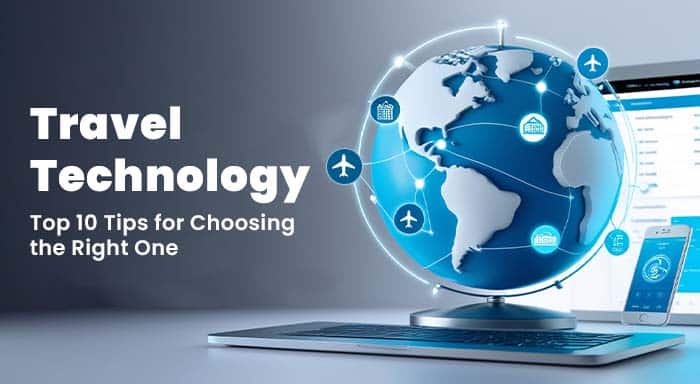Technology has transcended every aspect of our lives but have you ever considered how it is redefining the way we travel? From seamless flight bookings to apps that keep you connected worldwide, the right travel tech can make all the difference. Whether you're a globetrotter, a travel agency owner, or a tourism professional, choosing the best tools can elevate your travel experience like never before. In this piece, let us explore the best tips for selecting the right technology for traveling.
Tips For Choosing The Right Travel Technology
1. Assessing Your Travel Needs and Preferences
When choosing the right travel technology, it’s crucial to first evaluate your personal travel needs. Define your expectations and preferences that will help find the best tool, accommodating all your needs and delivering you optimal convenience. Frequent business travelers require constant connectivity and streamlined solutions. For such professionals, using business travel management software simplifies bookings and reduces the total travel costs. On the other side, leisure travelers may have different priorities when selecting their tech tools.
Priorities are quite different for people who are business travelers and for people who are going on holiday. For frequent travelers, Holafly's eSIM with unlimited data offers seamless international connectivity, ensuring you stay connected without the hassle of swapping SIM cards or dealing with expensive roaming fees.
Key considerations:
- Frequency of Travel: Frequent travelers may prioritize tools like apps for faster check-ins or connectivity solutions, while occasional travelers might focus on budgeting tools and accommodation apps.
- Destination Types: If you often travel to remote or less connected destinations, you may need technology that works offline or in areas with limited connectivity.
- Budget: A tech solution’s cost is important, especially when considering features. If you know what your needs are you can better choose what features you need. Strike a fine balance between value and price. Consider whether the premium features meet your needs or whether they justify the price.
Analyze and gain a deeper understanding of your travel needs and patterns. In this way, you will be in a better position to select the technologies that can only elevate your travel experience.
2. Prioritize User Experience and Interface Design
The seamless user experience is a significant consideration when it comes to choosing travel technology. By the way, no user would prefer to spend their entire holiday time figuring out the features and functionalities of the application. The user interface ought to be usable intuitively and user-centered.
Travel platforms with neat, organized, and simple designs do play a significant role in making sure that the process of booking is seamless, minimizing confusion and hassle, which is significant at the time of traveling. Search for platforms with easy navigation, even if you're not very tech-savvy.
3. Look for Real-Time Data and Updates
It's about staying informed in real-time once en route; just think of landing in a foreign country, and discovering that your flight has been delayed or there's a problem with your hotel reservation. Imagine getting updated continuously on all changes like flight delays, boarding changes, weather updates, and other pertinent information.
Such notifications and useful changes are there to help one adapt to the changes. This is especially true in the case of business travelers for whom staying on top of changing itineraries or emergencies is of critical importance. This is why real-time data and updates provide utility.
4. Integration with Multiple Platforms and Devices
Travel technology works best when it can be used across devices and provides seamless integration with various providers. You don’t want to be switching apps and platforms in the middle of your trip.
Cloud-Based Technology
Find those that support syncing with cloud technology, meaning you can get into your travel plans from anywhere - whether your smartphone, tablet, or laptop. This would enable you to view everything, from bookings to itineraries, in one place, thus streamlining everything.
Device Compatibility
Many travel tools are now designed to work across platforms, so check whether your chosen technology works well on different operating systems (Android, iOS, Windows).
5. Security Features and Data Privacy
As travelers, we give technology a lot of sensitive information from passport numbers to credit card numbers and individual itineraries. The protection of this data should be given top priority.
Key Security Features to Look For:
- Two-Factor Authentication (2FA): Provides an additional layer of security, ensuring that your accounts are safe even if your password is compromised.
- End-to-End Encryption: Guarantees that your data is securely transmitted, without the risk of interception by third parties.
- Privacy Policies: Always review a service’s privacy policy to understand how your data will be used and protected.
6. Cost-Effectiveness vs. High-End Features
When choosing travel technology is relatively easy to get overwhelmed by the higher-end shiny features. One thing to note is that all those premium tools do not offer key functionalities that will specifically help you in your travels.
Finding the Balance
Before committing to any travel tool, assess whether the additional features are necessary or if you can do without them. For example, you may not need every luxury feature in a travel app if you’re mainly looking for booking and itinerary management.
7. Compatibility with Travel Providers and Services
However, more emphasis should be placed on travel technology seamlessly interfacing with airlines, hotel bookings, car rentals, and other suppliers. Non-integrated Trip Management tools will give rise to system interruptions at different levels of booking and management of a trip.
Streamlining the Booking Process
Look for platforms that work well with multiple travel providers. For instance, flight booking via applications that also let you book car rentals and hotels also greatly streamline the process of trip planning.
Risks of Incompatibility
Choosing a travel app that doesn't integrate well with other services might result in problems like double bookings or missed reservations. Make sure that your platform is cohesive with other important services and that no above-mentioned issues are likely.
8. Assessing Customer Support and Service
Traveling to a destination is usually accompanied by concerns of canceled flights or other such inconveniences, but the incessant support from a customer service team is priceless if anything does go wrong.
Reliable Support Systems
It is imperative to choose travel technology platforms that are customer service-friendly and adept at effective complaint resolution. Usually, the complaint resolution is through live chats, emails, and even by phone.
9. Sustainability and Eco-Friendly Options
The growing trend of sustainable travel has influenced travel technology. Multiple tech solutions nowadays prioritize eco-friendly characteristics that enable travelers to reduce their impact on the environment.
Green Travel Technology
Sustainable solutions for traveling, such as apps that track the offsetting of carbon, environmental accommodation, or rentals of an electric car must be sought in traveling. In all these respects, they suit a traveler wishing to reduce the carbon footprint caused on the move.
10. Get Useful Recommendations and Go Through Reviews Left by Previous Travelers
One should always read reviews from other users beforehand before investing in any travel technology. Fellow travelers will provide the best basis for assessment of the technology's dependability, usability, and other comprehensible features expected in the travel technology solution.
Peer Recommendations
Travel communities, forums, and various social media networks help render recommendations. However, numerous travel applications also enable travelers to share their travel experience with other travelers and specify which aspect was suitable and which was not.
Reviews of Users
Travelers always leave reviews detailing their experience of the destination, journey, and stay. Explore the review sites to go through some of these reviews and find out whether any traveler has mentioned any insights about your preferred technology choices.
Conclusion
The industry of travel technology is large and wide with a lot of options. Travelers must make the right choice to get total convenience while traveling, enhancing their overall experience. Making the right choice depends on a thorough evaluation of requirements, prioritizing the interface and user-friendliness of the applications as well as cost and security among all the other aspects. Be it an individual or a travel business, the right tools make the difference between a smooth and efficient journey.
FAQs
What are the key features I should look for in a travel app?
Finding the right app becomes easy when you know what features you want. Essentially, you must focus on convenience, integration features with different services, optimal security characteristics, timely updates, etc. Apps should have a user-friendly interface, with essential tools readily accessible.
What characteristics determine the best travel technology for businesses?
Pay attention to platforms that improve customer service, simplify operations, and ensure smooth integration with present systems. Search for platforms that make it quite easy to manage itineraries, bookings, and customer information.
Is it possible to find a travel technology that also supports sustainable travel?
Yes, some several platforms and apps nowadays provide various environment-friendly options like sustainable accommodations, carbon offsetting, and green transport options, allowing travelers to reduce negative impact on environment and travel in an eco-friendly manner.



